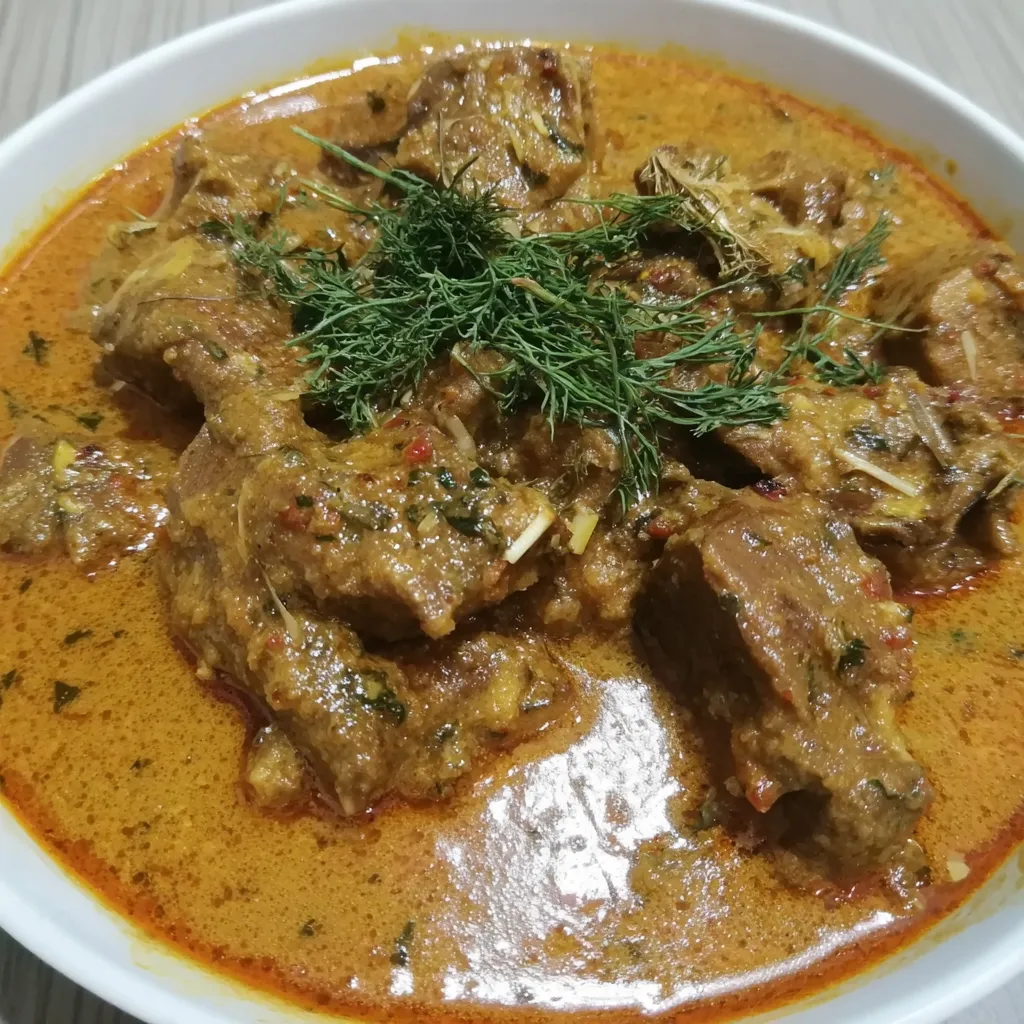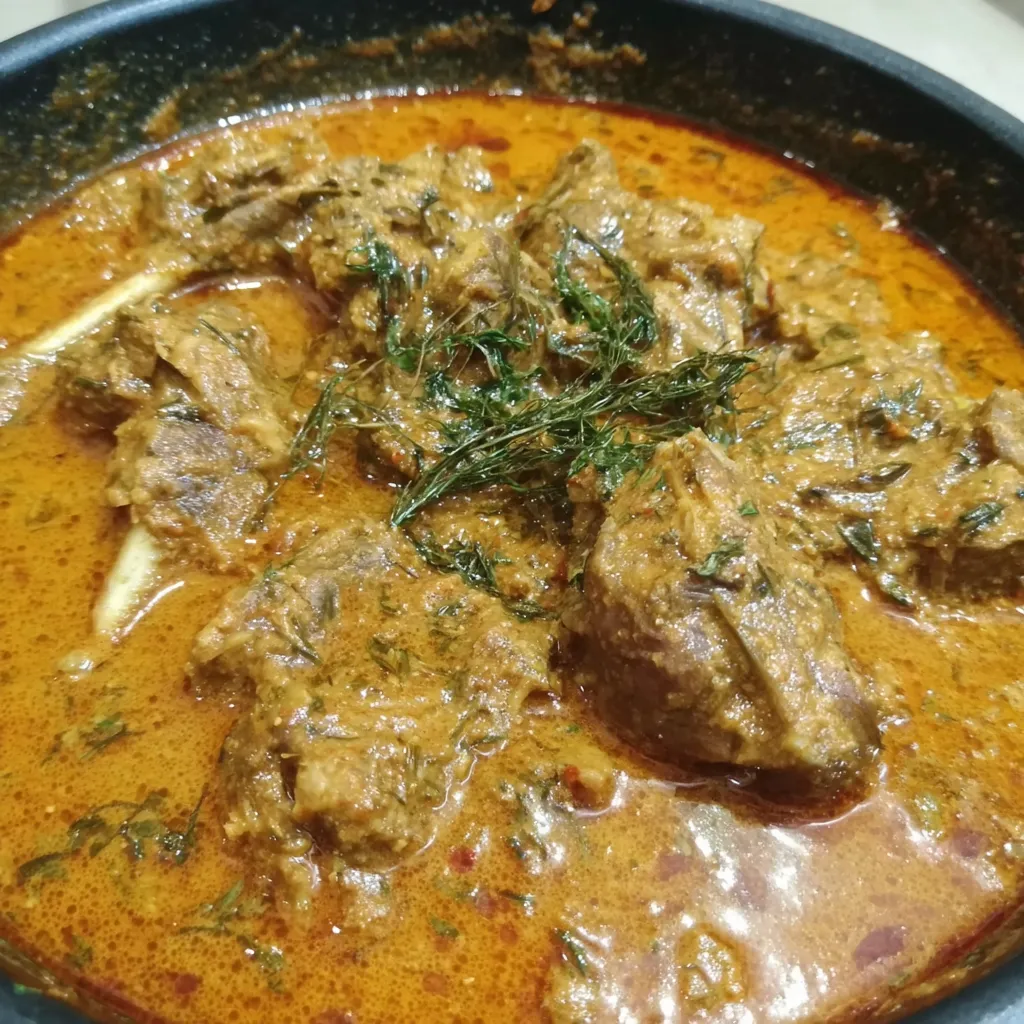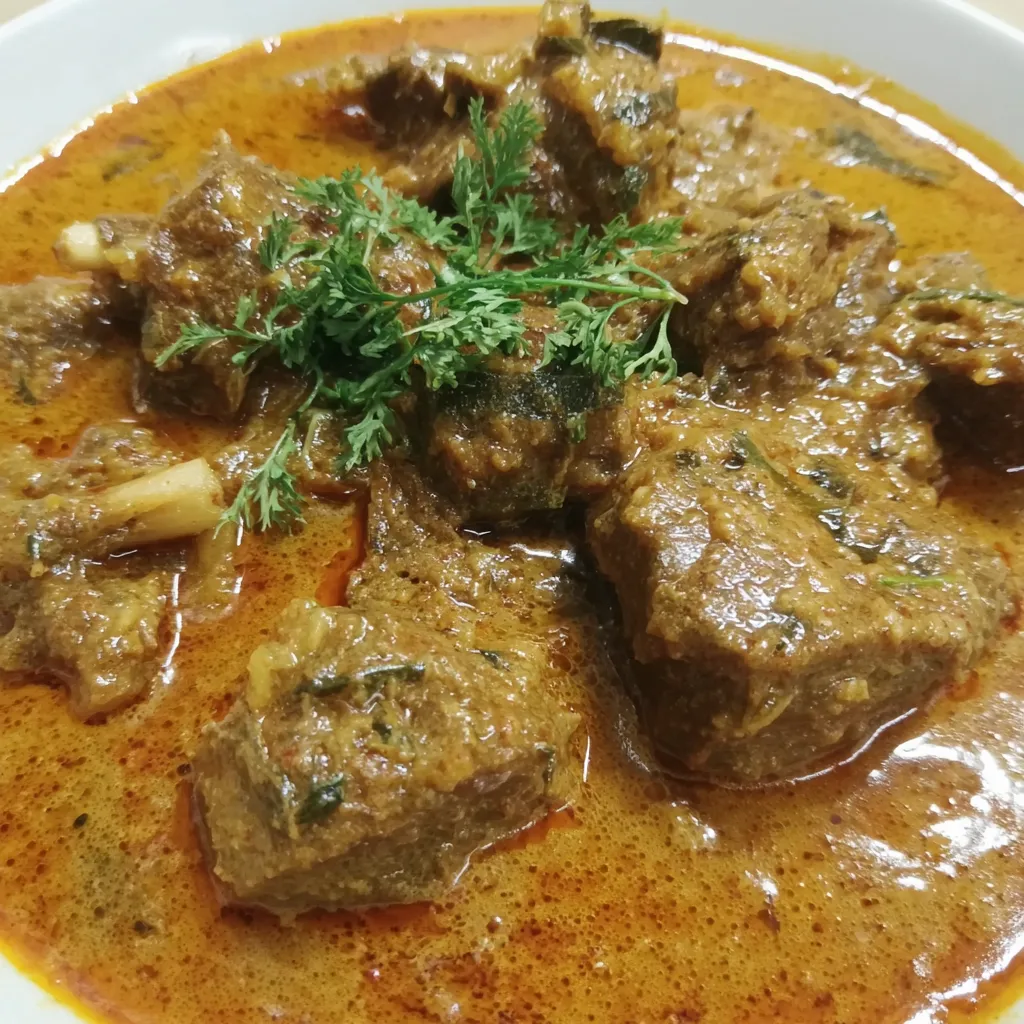 Pin it
Pin it
Railway Mutton Curry was a cherished comfort during long train journeys and still carries that nostalgic old-world charm. This recipe brings the warmth and robust flavors of historic railway cuisine into your own kitchen with tender mutton simmered in a delicately spiced coconut and tamarind gravy.
My love for this curry began after tasting it on a train journey as a child. Now making it at home brings back the same warmth and the aroma always draws everyone to the kitchen.
Ingredients
- Mutton bone-in: adds richness and slow cooks to release incredible flavor and body into the curry. Always choose fresh cuts with some fat and bone for authenticity.
- Onion: forms the base sweetness. Thinly sliced onions caramelize beautifully so choose yellow or red onions with tight skins.
- Tomato: offers gentle tanginess and body. Use ripe red tomatoes for their natural sweetness.
- Ginger garlic paste: brings aroma and depth. Fresh paste is best for robust flavor.
- Curry leaves: lend a unique fragrance. Look for fresh deep green leaves without black spots.
- Green chili: provides heat. Adjust the number based on your spice preference and choose firm bright chilies.
- Mustard seeds and fennel seeds: are classic tempering spices. Whole seeds ensure bursts of warm flavor.
- Turmeric powder: gives earthiness and color. Opt for a fresh and naturally bright yellow powder.
- Red chili powder: builds warmth. Use Kashmiri chili powder for color or hot chili for extra heat.
- Coriander powder: adds citrusy notes. Freshly ground is most aromatic.
- Garam masala: rounds out the flavors. Homemade or a favorite brand works well.
- Black pepper powder: adds warmth and a gentle tingle on the palate.
- Tamarind pulp: gives the signature tanginess. Soak whole tamarind if using, and always strain the pulp.
- Thin coconut milk: builds the sauce base. Opt for fresh or good quality canned coconut milk shaken well.
- Thick coconut milk: enriches the curry at the end for creaminess. Avoid low-fat versions.
- Salt: brings everything together. Taste and adjust gradually.
- Oil: is essential for blooming all the spices. Use a neutral oil or coconut oil for extra flavor.
- Fresh coriander: brings brightness at the end. Pick crisp leaves and tender stems for garnish.
Step-by-Step Instructions
- Prepare the Aromatic Tempering:
- Heat oil in a heavy-bottomed pot on medium and add mustard seeds and fennel seeds. Wait until the seeds begin to splutter and release their fragrance. This step infuses warmth into the oil and forms the foundation of the curry’s flavor.
- Build the Flavor Base:
- Add curry leaves and slit green chilies to the hot oil. As the leaves sizzle, immediately stir in the thinly sliced onions. Sauté slowly for at least eight to ten minutes until the onions turn golden brown and caramelized, stirring often so they do not burn.
- Develop the Masala:
- Lower the heat and add ginger garlic paste. Cook for two to three minutes until the raw aroma disappears and the paste is fragrant and golden.
- Simmer the Tomatoes:
- Add chopped tomatoes to the onion-spice mix. Sprinkle with a pinch of salt, then cook for several minutes until the tomatoes break down and turn soft and mushy. Stir to prevent sticking and allow the mixture to become saucy.
- Bloom the Spices:
- Add turmeric powder, red chili powder, coriander powder, and black pepper powder. Sauté the spices into the tomato-onion mixture for about two minutes until the oil separates and the masala looks glossy. This blooming step deepens every spice’s flavor.
- Brown the Mutton:
- Add the mutton pieces and salt. Sauté for a good ten to fifteen minutes, stirring and flipping the meat so every piece is well coated and browns slightly. Building color on the meat helps bring out maximum flavor in the finished curry.
- Curry Cooking:
- Pour in tamarind pulp and thin coconut milk. Give a good stir and ensure the meat is submerged in the liquid. Cover the pot tightly and simmer gently for forty five to sixty minutes, stirring occasionally. For faster results, seal your pressure cooker and cook for three to four whistles. The slow simmer allows mutton to become completely tender.
- Finish with Richness:
- Once the mutton yields easily to a fork, add thick coconut milk and garam masala. Simmer gently uncovered for three to four minutes without letting the curry come to a boil. This prevents coconut milk from splitting and keeps the sauce silky.
- Garnish and Rest:
- Taste for salt and adjust seasoning as needed. Sprinkle fresh coriander over the top and allow the curry to rest for five to ten minutes before serving to let the flavors meld together.
 Pin it
Pin it
The addition of fresh curry leaves always reminds me of my grandparents who grew them right outside their kitchen. Plucking them fresh is a small joy and their bright scent brings every batch of this curry to life.
Storage Tips
This curry actually tastes better the next day since the flavors deepen. Store cooled leftovers in an airtight container and refrigerate for up to three days. I like to reheat gently on the stovetop and add a splash of water or coconut milk if the sauce thickens.
Ingredient Substitutions
If you cannot find mutton, goat or lamb makes a great substitute and follows the same cooking times. For a lighter dish, use chicken and reduce cooking time as it cooks faster. Coconut cream can replace thick coconut milk for extra richness if you like. Adjust chilies to suit your heat tolerance.
Serving Suggestions
Railway Mutton Curry is best paired with hot steamed rice or fluffy jeera rice for a traditional feel. If you want an authentic experience, serve with soft dinner rolls that soak up the gravy perfectly. We love adding a quick cucumber salad or lime wedges on the side for freshness.
 Pin it
Pin it
Cultural Context
This iconic recipe has roots in India’s railway dining cars, where cooks adapted British-style stews to Indian spices using pantry staples during long journeys. It showcases practical, flavorful cooking that could withstand hours on a moving train without losing taste or texture. Making it at home keeps those culinary memories alive.
Frequently Asked Questions
- → What cut of mutton works best?
Bone-in pieces, such as shoulder or leg, impart rich flavor and ensure tender results.
- → Why is coconut milk used?
Coconut milk adds creaminess and balances the heat and tang, giving the gravy a luscious texture.
- → How long should the mutton be cooked?
Simmer mutton on low for about 45–60 minutes until tender, or pressure cook for quicker results.
- → Is there a substitute for tamarind pulp?
Lemon juice can be used for tanginess, but authentic flavor is best achieved with tamarind.
- → What makes this curry ‘railway’ style?
The use of whole spices, coconut milk, and a gentle simmering method gives this curry its railway heritage.
- → Which sides pair well?
This curry is traditionally served with steamed rice, jeera rice, or soft dinner rolls for soaking up the rich sauce.
